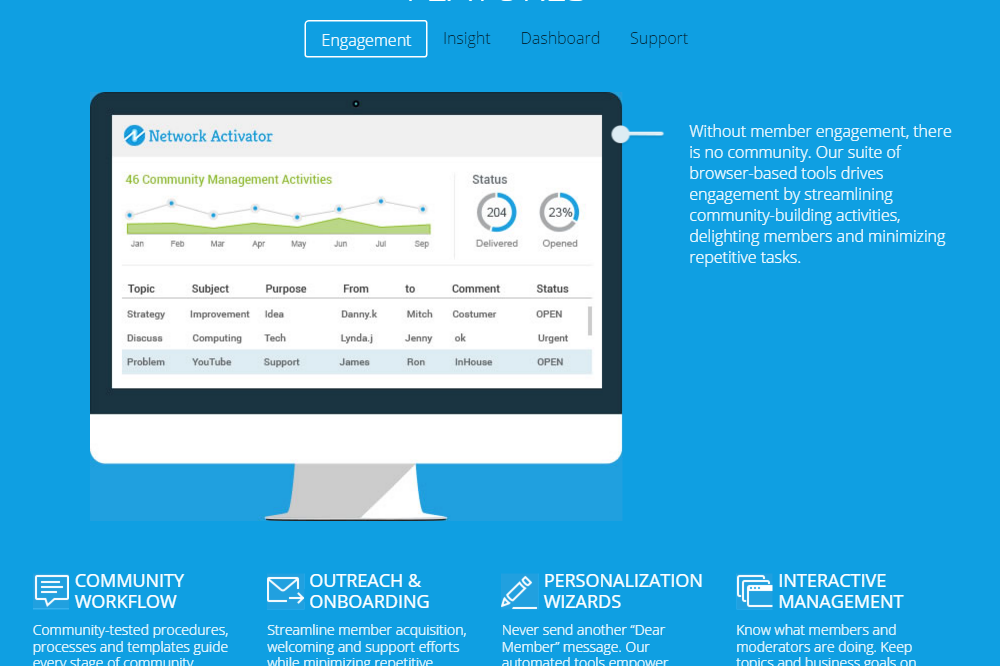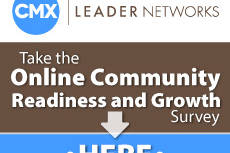Community champions within an enterprise can be hard to find. They are far too busy delivering results to wave their own flag. These “intrapreneurs” — the risk takers and shepherds of innovation and organizational change — should be celebrated! We periodically spotlight online community leaders here, so I’m pleased to share a discussion with my friend and colleague Lauren Klein.
Lauren is a community consultant with a specialty in building employee-to-employee communities. Most recently, she was a Director for the Communities Program in the Learning Organization at Novell Inc. Lauren really knows her stuff. She’s published several papers in top knowledge management trade journals and magazines, and lectures on KM and communities.
What are E2E communities and why are they important?
Employee-to-Employee (E2E) communities vary from company to company. IBM is an example of a company that supports initiatives to increase openness, ranging from their early adoption of wikis and blogs to the notion of jams and social network analysis. Today, many organizations are thinking about the impact of social networking, collaboration and sharing as a core part of their business. Cisco, for example, has been doing work in this area for years. Zappos not only lives this, but is also giving back through Zappos Insights. IBM, Cisco and Zappos are improving employee engagement and productivity through this transparent and open model that mirrors the consumer world in which they operate.
What is their purpose?
Most communities I’ve been involved with are structured around a problem that needs to be solved, such as a Community of Interest in a domain where members want to solve organizational, cultural or social problems through knowledge sharing and innovation. Today’s organizations have communities based around geographies, functions, roles, products – many different domains. It’s like a library: the more books on the shelf, the more possibilities available. While many of today’s communities encompass customer or prospect feedback, there is a great opportunity to connect these communities with online communities of employees.
What does it cost to create an E2E community?
It depends on the scope. If you have an existing infrastructure for online communities, you can invite your employees in while setting up an area which is private, for employees only. As with any project, it depends on how you structure it. I’ve seen success with a million dollar budget and several FTEs who travel the globe as a team offering educational training, research and connection services as well as community leadership workshops. This was for a billion dollar company that had a 20 person team. It’s important for executives to invest time in understanding the strategies around social computing guidelines and education.
Maintaining a community will depend on your community goals. Do you want a high value for the time relationship with each member? That could cost you 1 FTE aligned with every 70 members at $100K per person. Then scale the numbers accordingly.
What are some of the tangible benefits?
If you invest in your customers and/or employees you will see increased commitment. If you are investing in an account relationship for your organization, the cost is minimal for 1FTE if you have a million dollar account. If your community managers spend time helping your accounts get familiar with existing resources, products or services, this could generate new revenue and help you to grow your business. It depends on the objective and focus of the community management role. How do you measure their success? Tie community manager activities to revenue, renewal or subscription rates, or add-on product sales. You could look at it from a customer satisfaction rating, etc. It depends on what business drivers you want to influence.
How do E2E communities compare to B2B and B2C communities?
B2B can be a business-to-business, an association with other groups within an association or an NGO with a shared commitment to solve problems, share information and/or learn together. In B2C, or business-to-consumer communities, we often see individual consumers and partners in the supply chain participate and partner to solve or share problems, discuss new products and innovations or receive support. It depends on the charter or mission of the community. In an association community, you may see that the sponsoring community provides a space to allow all their supporters and fans innovate, share and learn together. For some people, a twitter conversation with a celebrity is considered another form of a B2C community.
The opportunity for E2E is for leadership to encourage marketing channels (typical B2C channel sponsors) to innovate and invite all employees, consumers and partners to learn and engage socially in conversations to drive business imperatives. We have an opportunity with new media to open ourselves up to model new behaviors, such as IBM with their BlueTwit product, where executives can microblog around a variety of topics. They are now walking the talk to allow employees to feel more connected with their executives in a new way. For some people, this can feel inspirational and drive new commitments. This can break down silos and foster new forms of open communications.
Are companies connecting their E2E communities with B2C?
Today, employee-to-employee communities are closed and private, which provides a safe space for employees to communicate, innovate and give feedback — a virtual sandbox for online communications. Where cultures can transform themselves is by thinking about flow and openness within their organizational structures and cultures.
Many organizations have adopted new media and have Facebook pages, Twitter accounts and marketing campaigns using social media. However, what I’m hoping to see is the energy and translation of these into possibilities among employees inside the firewall and with consumer and partner channels outside, which will drive business imperatives and transform cultures.
Best Buy had a grassroots effort which created Twelpforce, yet personally, I’ve have experienced both Twelpforce success and the absence of this interaction and passion at the local big box store culture level. The culture of operating openly hasn’t filtered throughout the organization. Many organizations have stand-alone channels for B2C that are amazing, and stand-alone E2E programs. The power will be greatest when we are able to connect and weave them together.
What are the critical success factors for creating an E2E community?
1) Be deliberate about investing in community as part of your company culture. What does this mean? Invest in these concepts as the foundation for all programs in your culture handbook: competency, leadership and performance management programs. Don’t view culture as an expense. Instead, think of it as a critical talent and retention engine, which will create a stronger company and allow you to plan for the future.
2) Set up accountability programs for senior leaders in “social engagement.” Create a blueprint for your culture and help your senior leadership be accountable. Encourage your staff to blog, tweet, update, livestream or livecast in an interactive and collaborative manner with employees, partners and shareholders. Ask product management to open up road maps and innovations, to open multiple channels for dialogue and real time feedback Encourage leaders within organizations to tweet, blog or use video clips as a real time approach to sharing their day-to-day experiences, thinking and how they are evolving their thoughts based on input from the various channels. This will allow customers, prospects and employees to experience how their input and commitment matters.
3) Invest in “social” talent, training and programs. Consider offering sandboxes where people can practice, “walk the talk” and learn together around the notion of “Social Digital Diplomacy’. Embed new media approaches in your executive and leadership development programs. Bring in the X and Y generation from other companies which talk to your senior leaders so that they can understand what makes them loyal employees, what motivates them and/or how they want to engage socially.
What are the common missteps and how to avoid them?
1) Setting up E2E communities for an exclusive line of business. Avoid creating community or social channels only for a specific function in the business, such as marketing. E2E programs foster new opportunities, so why not invite employees to create their own community and collaborative structure to help break through their perceived set of barriers to the vision or business imperatives.
2) Slapping new media solutions onto an old process. Implementing these changes can be costly long-term if you don’t spend the necessary time up front to do business planning that includes social media and product or service innovation to drive new possibilities through this new media.
3) Lack of cross functional “team think” can be helpful only if you want to get something out the door quickly. However, it does require governance or cross functional thinking to innovate and find new possibilities that wouldn’t happen without multiple perspectives. How would you go about structuring a team think? Engage people that do network mapping to find individuals in your communities who are influencing others. Bring them into the product and service discussions to help broker new thinking and ideas. If this is an employee-only conversation, why not bring in customers, partners or supply chain into the discussion for the full 360 to help you look around the corners.
4) Not engaging your customers, clients or shareholders into the discovery process. This can be costly long-term as you might fail to identify what your customers really need, expect and/or want. People are already interconnected, they are the network that nourishes us today and needs to be part of the counsel to help you understand what works and makes a difference today and what could work and make a difference tomorrow. That isn’t to say we don’t look outside our eco-system, but certainly they are all customers. Many of the best products on the market were directly related to customer input, so we need to embrace this and not fear it. Apple is dominating the tablet market due to their listening to their customers and incorporating that into their strategy, despite what Wall Street may have told them. It takes courage to consider new ways of behaving.
Warning: Attempt to read property "base" on array in /home3/trusten9/public_html/leadernetworks/wp-content/plugins/wp-user-profile-avatar/shortcodes/wp-user-profile-avatar-shortcodes.php on line 665
Warning: Attempt to read property "base" on array in /home3/trusten9/public_html/leadernetworks/wp-content/plugins/wp-user-profile-avatar/shortcodes/wp-user-profile-avatar-shortcodes.php on line 665
Warning: Attempt to read property "base" on array in /home3/trusten9/public_html/leadernetworks/wp-content/plugins/wp-user-profile-avatar/shortcodes/wp-user-profile-avatar-shortcodes.php on line 665
Warning: Attempt to read property "base" on array in /home3/trusten9/public_html/leadernetworks/wp-content/plugins/wp-user-profile-avatar/shortcodes/wp-user-profile-avatar-shortcodes.php on line 665
Related Posts
July 10, 2018
How To Increase User Engagement in your Online Community
Every member goes through four stages of activity within an online community:…
October 26, 2015
Online Community Managers: A Tool of Our Own!
For years, social media marketers have had tools like Hootsuite, Sprinklr, and…
October 15, 2015
Announcing: Online Community Readiness and Growth Research Study
A new study to find the keys to community readiness and growth
2 Comments
Add comment Cancel reply
This site uses Akismet to reduce spam. Learn how your comment data is processed.




Nice post! As business owners, your employees are very useful. They’re one of those who contributed a lot for your business so you have must to give them importance. You should treat them as if they were your business partners.
It’s amazing to visit this site and reading the views of all mates
on the topic of this post, while I am also zealous of getting knowledge.